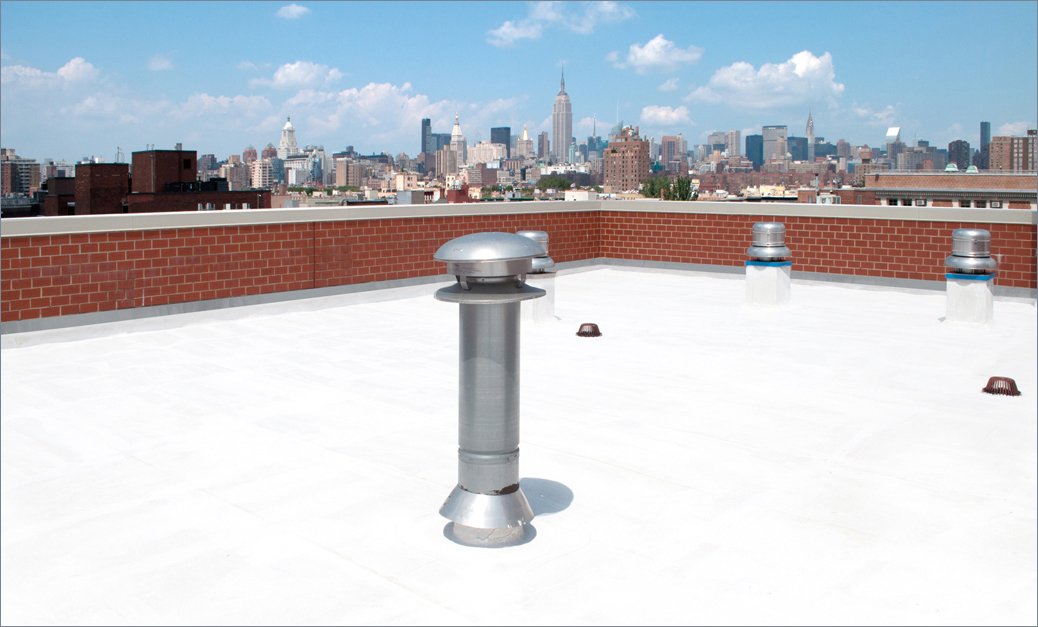In 2012, the Center for Environmental Innovation in Roofing launched RoofPoint, a voluntary, consensus-based sustainable roof rating system developed by the center to help building owners and designers select nonresidential roof systems based on long-term energy and environmental benefits.
The program ensures new and replacement roof systems are designed, installed and maintained in accordance with the best sustainable practices available. It serves as a checklist to identify the ways current roof systems provide economic value and protect the environment; guidelines to establish design, installation and maintenance criteria for selecting sustainable roof systems; an assessment system to compare sustainable roofing strategies and choose the optimal roof systems for any building and site condition; and a recognition program to validate roof system selection and reward environmental innovation in roofing.
The rating system features 23 strategies to address critical environmental aspects of modern roof systems. The strategies are scored against measurable goals, and the project assessment is expressed as a total point score. Roofing projects that meet a minimum score in each major category and overall are recognized as demonstrating the key principles of sustainable roofing.
"Roofing contractors can use RoofPoint to differentiate themselves from their competitors by marketing RoofPoint roof systems not only as environmentally friendly but also long-lasting, durable and energy-efficient," says James Kirby, the center's vice president of sustainability.
During the past year, the center has realized various achievements involving the RoofPoint system and has numerous goals planned for 2015 and beyond.
Project update
Since RoofPoint's inception, there have been 504 projects submitted; 302 of those projects have been approved and registered. Twenty-four projects have been submitted this year, and 14 have been approved and registered.
During the past two years, the center has directed considerable resources toward simplifying the evaluation and submission process for construction professionals who want to participate in the RoofPoint program. To start the process, new participants must register for a free user account, providing them with a personal home page for all their roofing projects. Registered users then have access to a step-by-step project evaluation process that features a running tally of the credits each project has achieved, as well as fast links to helpful scoring guidelines.
Since the RoofPoint website went live in 2012, 262 construction professionals have registered as RoofPoint users, and 54 new users have signed up during the past six months.
"The relatively large number of registered users, along with continuing interest from new users, suggests RoofPoint is starting to gain momentum in the building design community," says Jim Hoff, the center's vice president of research. "In fact, many new users are with engineering and architectural firms—one of our key target audiences."
The RoofPoint program includes new construction and reroofing projects. When RoofPoint began, 55 percent of registered projects were new roof system installations and 45 percent were reroofing projects. More recently, that shifted—35 percent of registered projects are new roof system installations and 65 percent are reroofing projects, reflecting the ratio of overall roof system installations in the U.S.
As RoofPoint gains momentum, the center has begun to launch additional initiatives through the program.
RoofPoint Registered Professionals
During the 2014 International Roofing Expo® in Las Vegas in February, the center introduced the RoofPoint Registered Professional (RRP) program and its first class of RRPs. The RRP program is the first major initiative launched through RoofPoint since the program was presented to the public in October 2012.
The RRP program's mission is to develop a group of experienced professionals representing all key roofing stakeholders who have demonstrated competency in the application of the RoofPointCM Guideline for Environmentally Innovative Nonresidential Roofing to evaluate individual roofing projects.
"RRPs represent a dedicated group of professionals in the roofing industry who make critical contributions every day to sustainable construction and whose work helps showcase the critical role roof systems play in mitigating the impact buildings have on our environment," says Craig Silvertooth, the center's president.
There are 23 RRPs from the pilot program, which the center conducted during 2013 to verify the application and exam process.
RRPs can provide services to building owners, facility managers and other building designers interested in achieving the RoofPoint designation for their projects. In addition to evaluating and scoring roofing projects, they can design energy-efficient, long-lasting, durable roof systems that are environmentally friendly and meet codes and standards. RRPs also can install and maintain roof systems to help ensure longevity and high performance. The inaugural class of RRPs included professionals representing each key sector of the roofing industry: contractor, consultant/designer and manufacturer.
Building designers, roof consultants, roofing contractors, facility managers, manufacturer representatives and many other roofing-related occupations are eligible for the RRP program. Individuals with five years of roofing-related work experience or three years of experience and a post-secondary degree can also apply.
Individuals interested in becoming RRPs must meet eligibility requirements and pass the online RRP Examination. Once they pass the exam, applicants are notified of their RRP status and provided with a certificate and additional program materials. The initial certification period is three years, with renewal every three years contingent on meeting practice and continuing education requirements.
RRPs are qualified to evaluate and score roofing projects in accordance with the RoofPoint guideline's credit requirements and offer suggestions regarding how to meet or exceed RoofPoint credits.
"Roof system designers and installers who are RRPs essentially can guarantee RoofPoint certification, so their clients will know before a project starts the certification will be achieved," Kirby says.
RRPs are listed prominently on RoofPoint's website under "Find a RoofPoint Professional" to showcase their achievements.
Becoming a standard
The center is working with The Roofing Industry Alliance for Progress to update and republish the RoofPoint guideline as a standard in accordance with the consensus process of the American National Standards Institute (ANSI). The first public version of the guideline was released in 2012. According to industry-accepted standards, the guideline is due for an update and republication in 2015.
Developing RoofPoint into an industry-wide, consensus-based standard will provide the program with additional credibility to grow market share in the public and private sectors, as well as present the opportunity for the program to be incorporated into other standards, regulations and codes that could mandate its use.
The Alliance agreed to provide funding for the project, with the center reporting its progress quarterly.
The ANSI initiative was discussed at the center's Research Committee meeting April 30 in Denver, and the center's ANSI task force was formed.
"Transforming RoofPoint into a recognized national standard will be critical to the program's ongoing success," Hoff says. "Having a national standard opens doors to inclusion in public procurement programs and is highly favored in specifications by architects and engineers."
This project is set to be completed by the end of 2015 or early 2016.
Future projects
The center will continue to promote its strategic plan in 2015, including its RRP program and the ANSI process initiative for the RoofPoint guideline. The center's board of directors also is working on an extensive marketing campaign for 2015, which includes developing strategic partners to help promote the RoofPoint program.
"The roofing industry has a significant opportunity to work together and move the industry forward to be more environmentally friendly," Kirby says. "RoofPoint provides that opportunity."
Krista Berns is Professional Roofing's director of online communications.
For articles related to this topic, see:
"A sustainable system," May 2013 issue
"A RoofPoint report," December 2011 issue
"A roof rating system," December 2010 issue



